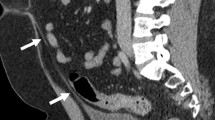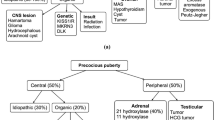Abstract
The authors present the unusual case of a 15-year-old boy with a primary empty sella caused by non-communicating hydrocephalus due to fourth ventricle outflow obstruction whose secondary symptoms of growth hormone deficiency and delayed puberty were successfully treated by endoscopic third ventriculocisternostomy (ETV). Hypopituitarism occurs only rarely in cases of hydrocephalus; rarer still are cases where hypopituitarism is the sole symptom of hydrocephalus. A primary empty sella may indicate elevated intracranial pressure; if the cause is non-communicating hydrocephalus, ETV is indicated as the preferred treatment modality.



Similar content being viewed by others
References
Barkovich AJ, Millen KJ, Dobyns WB (2009) A developmental and genetic classification for midbrain-hindbrain malformations. Brain J Neurol 132(Pt 12):3199–3230
Bayston R (2019) Cerebrospinal fluid shunt infection: microbiological basis. In: Cinalli G, Özek MM, Sainte-Rose C (eds) Pediatr. Hydroceph. Springer International Publishing, Cham, pp 1309–1322
Busch W (1951) Morphology of sella turcica and its relation to the pituitary gland. Virchows Arch Pathol Anat Physiol Klin Med 320(5):437–458
Caporal R, Segrestaa JM, Dorf G (1983) Endocrine expressions of hydrocephalus. A case of primary amenorrhoea revealing a stenosis of the foramen of Magendie. Acta Endocrinol 102(2):161–166
Chiloiro S, Giampietro A, Bianchi A, Tartaglione T, Capobianco A, Anile C, De Marinis L (2017) Diagnosis of endocrine disease: primary empty Sella: a comprehensive review. Eur J Endocrinol 177(6):R275–R285
De Marinis L, Bonadonna S, Bianchi A, Maira G, Giustina A (2005) Primary empty Sella. J Clin Endocrinol Metab 90(9):5471–5477
Hamilton K, Iskandar B (2018) Amenorrhoea and reversible infertility due to obstructive hydrocephalus: literature review and case report. Br J Neurosurg 32(3):291–294
Kaye AH, Tress BM, Brownbill D, King J (1982) Intracranial pressure in patients with the empty Sella syndrome without benign intracranial hypertension. J Neurol Neurosurg Psychiatry 45(3):209–216
Kumar SS, Chumas P, Peckham D, Guthrie A, Murray RD (2010) Hypogonadotropic hypogonadism: a consequence of Chiari-I malformation. Pituitary 13(2):183–185
Lee JK, Kim JH, Kim JS, Kim TS, Jung S, Kim SH, Kang SS, Lee JH (2001) Secondary amenorrhea caused by hydrocephalus due to aqueductal stenosis : report of two cases. J Korean Med Sci 16(4):532–536
Lee T-C, Yang L-C, Huang P-L (2005) Treatment of empty sella syndrome with ventriculoperitoneal shunt. J Clin Neurosci 12(2):201–205
Lowry DW, Lowry DL, Berga SL, Adelson PD, Roberts MM (1996) Secondary amenorrhea due to hydrocephalus treated with endoscopic ventriculocisternostomy. Case report. J Neurosurg 85(6):1148–1152
Maira G, Anile C, Mangiola A (2005) Primary empty sella syndrome in a series of 142 patients. J Neurosurg 103(5):831–836
Moin T, Bergsneider M, Vespa P, Heaney AP (2012) Pituitary function in patients with normal pressure hydrocephalus before and after neurosurgical correction. J Clin Endocrinol Metab 97(10):3545–3549
Mortara R, Norrell H (1970) Consequences of a deficient sellar diaphragm. J Neurosurg 32(5):565–573
Nizamani WM, Siddiqui M, Ali Momin SN, Waqas M, Jooma R (2018) Resolution of symptomatic secondary empty sella syndrome following lumbar-peritoneal shunt. Surg Neurol Int 9:72
Pinto FCG, da Cunha Neto MBC, Rocha MGM, do Lago DV, Bronstein MD, Teixeira MJ (2011) Hypopituitarism due to hydrocephalus: case report and review of the literature. Pediatr Neurosurg 47(4):303–306
Pollock LJ (1915) Hypopituitarism in chronic hydrocephalus. J Am Med Assoc 5:395
Rhein JHW (1925) Hypophysial pressure symptoms due to hydrocephalus causing cystlike distention of the third ventricle. Arch Neurol Psychiatr 13(1):71
Spennato P, Mirone G, Nastro A, Buonocore MC, Ruggiero C, Trischitta V, Aliberti F, Cinalli G (2011) Hydrocephalus in Dandy-Walker malformation. Childs Nerv Syst 27(10):1665–1681
Tanrıkulu B, Özek MM (2019) Mechanical shunt complications. In: Cinalli G, Özek MM, Sainte-Rose C (eds) Pediatr. Hydroceph. Springer International Publishing, Cham, pp 1289–1307
Triggiani V, Giagulli VA, Moschetta M, Guastamacchia E (2016) An unusual case of reversible empty sella. Endocr Metab Immune Disord Drug Targets 16(2):154–156
Villani R, Tomei G, Gaini SM, Grimoldi N, Spagnoli D, Bello L (1995) Long-term outcome in aqueductal stenosis. Childs Nerv Syst 11(3):180–185
Zagardo MT, Cail WS, Kelman SE, Rothman MI (1996) Reversible empty sella in idiopathic intracranial hypertension: an indicator of successful therapy? AJNR Am J Neuroradiol 17(10):1953–1956
Author information
Authors and Affiliations
Corresponding author
Ethics declarations
Ethical approval
All procedures performed in studies involving human participants were in accordance with the ethical standards of the institutional and/or national research committee (name of institute/committee) and with the 1964 Helsinki declaration and its later amendments or comparable ethical standards.
Informed consent
Informed consent was obtained from the participant presented in the study.
Additional information
Publisher’s note
Springer Nature remains neutral with regard to jurisdictional claims in published maps and institutional affiliations.
This article is part of the Topical Collection on Pediatric Neurosurgery
Rights and permissions
About this article
Cite this article
Krejčí, T., Krejčí, O., Mrůzek, M. et al. Non-communicating hydrocephalus with a primary empty sella presenting with growth hormone deficiency and delayed puberty successfully treated by endoscopic third ventriculocisternostomy. Acta Neurochir 163, 511–514 (2021). https://doi.org/10.1007/s00701-020-04481-9
Received:
Accepted:
Published:
Issue Date:
DOI: https://doi.org/10.1007/s00701-020-04481-9




